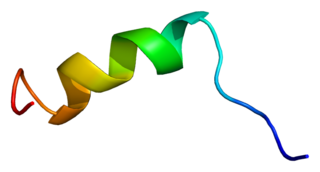Hemoglobin subunit epsilon is a protein that in humans is encoded by the HBE1 gene. [5]
Hemoglobin subunit epsilon is a protein that in humans is encoded by the HBE1 gene. [5]
The epsilon globin gene (HBE) is normally expressed in the embryonic yolk sac: two epsilon chains together with two zeta chains (an alpha-like globin) constitute the embryonic hemoglobin Hb Gower I; two epsilon chains together with two alpha chains form the embryonic Hb Gower II. Both of these embryonic hemoglobins are normally supplanted by fetal, and later, adult hemoglobin. The five beta-like globin genes are found within a 45 kb cluster on chromosome 11 in the following order: 5' - epsilon – gamma-G – gamma-A – delta – beta - 3'. [6]

The globins are a superfamily of heme-containing globular proteins, involved in binding and/or transporting oxygen. These proteins all incorporate the globin fold, a series of eight alpha helical segments. Two prominent members include myoglobin and hemoglobin. Both of these proteins reversibly bind oxygen via a heme prosthetic group. They are widely distributed in many organisms.
The human β-globin locus is composed of five genes located on a short region of chromosome 11, responsible for the creation of the beta parts of the oxygen transport protein Haemoglobin. This locus contains not only the beta globin gene but also delta, gamma-A, gamma-G, and epsilon globin. Expression of all of these genes is controlled by single locus control region (LCR), and the genes are differentially expressed throughout development.

N-myc proto-oncogene protein also known as N-Myc or basic helix-loop-helix protein 37 (bHLHe37), is a protein that in humans is encoded by the MYCN gene.

Hemoglobin subunit gamma-1 is a protein that in humans is encoded by the HBG1 gene.

Navα1.2, also known as the sodium channel, voltage-gated, type II, alpha subunit is a protein that in humans is encoded by the SCN2A gene. Functional sodium channels contain an ion conductive alpha subunit and one or more regulatory beta subunits. Sodium channels which contain the Navα1.2 subunit are called Nav1.2 channels.

Hemoglobin subunit zeta is a protein that in humans is encoded by the HBZ gene.

Gamma-aminobutyric acid receptor subunit beta-1 is a protein that in humans is encoded by the GABRB1 gene.

Homeobox protein DLX-4 is a protein that in humans is encoded by the DLX4 gene.

Quaking homolog, KH domain RNA binding (mouse), also known as QKI, is a protein which in humans is encoded by the QKI gene.

Olfactory receptor 52A1 is a protein that in humans is encoded by the OR52A1 gene.

Olfactory receptor 51B5 is a protein that in humans is encoded by the OR51B5 gene.

Olfactory receptor 51V1 is a protein that in humans is encoded by the OR51V1 gene.

Olfactory receptor 51B6 is a protein that in humans is encoded by the OR51B6 gene.

Olfactory receptor 51M1 is a protein that in humans is encoded by the OR51M1 gene.

Olfactory receptor 52A5 is a protein that in humans is encoded by the OR52A5 gene.

Olfactory receptor 51I1 is a protein that in humans is encoded by the OR51I1 gene.

Olfactory receptor 51I2 is a protein that in humans is encoded by the OR51I2 gene.
Hemoglobin, alpha pseudogene 1, also known as HBAP1, is a human gene.

Hemoglobin subunit theta-1 is a protein that in humans is encoded by the HBQ1 gene.

HBS1 like translational GTPase is a protein that in humans is encoded by the HBS1L gene.
This article incorporates text from the United States National Library of Medicine, which is in the public domain.